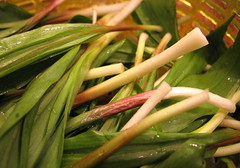
Pasta with ramps; ramps with pasta — we've had this for dinner twice in the past two weeks and if I can find more ramps this week we'll have it again. This year's ramps seem to be milder in flavor and less pungent than in previous years, possibly because of the wet weather we had recently, but I love them anyhow.
My understanding is that ramps are wild leeks that grow in mountainous regions in parts of the U.S. for just a few weeks each spring. They are the first item I've looked up in
The Oxford Companion to Food and not found an entry for; nor is there any information about them in the entry on leeks. I have only heard of them growing in the Catskills and the Appalachian Mountains, but quite possibly they are found elsewhere.
It's hard for me to explain what it is about ramps that I love so much, but I think it's their texture as much as their flavor: they come as close to melting as any vegetable can. They are at their best when prepared simply and served with minimal distractions.
The recipe below is basically a stripped-down version of
a recipe that appeared on Gothamist in 2006. My version of it has three changes: (1) I believe fresh pasta, not dried, is a far better partner for the ramps. Cooked just right, fresh pasta and ramps will have the same luscious texture. (2) I omitted the pork. The original recipe calls for speck, prosciutto, or bacon, and while I love all three of those things, I prefer my pasta with ramps as simple as possible. (3) I use only one egg, in deference to Italian Boyfriends of The Past who used one egg, not two, to make me perfect plates of pasta with grated cheese.
A couple more thoughts before the recipe: Like leeks, ramps are grubby little things that need to be washed in at least two changes of water, possibly three. The easiest way to wash them is, of course, with a salad spinner: Pull off any slimy outer layer (sometimes covering the bottom two-thirds of the white and pale purple parts) and trim off the frizzled ends of the bulbs, wash them well in plenty of cold water, and spin them dry. Second, I have noticed a lot of people walking away from the farm stand with a single bundle of ramps — a perfectly reasonable way to try an unfamiliar vegetable, but for this and most other dinner recipes you'll need at least two bundles. If you only have one lonely bundle, either halve the recipe and serve the pasta as an appetizer, or make ramps and scrambled eggs for 2 instead. (Chop the bulbs, cook them until soft in a combination of butter and olive oil; then add the greens and cook for a minute or two longer, until they are thoroughly wilted; then add 4 or 5 beaten eggs and scramble as usual).

 Fresh pasta with ramps
Fresh pasta with rampsServes 3-4.
2 bundles of ramps, washed thoroughly
1 pound fresh pasta, any flat ribbon shape (tagliatelle, linguine, fettucine)
2 tablespoons olive oil
2 to 3 tablespoons butter
salt and freshly ground pepper
1 egg, lightly beaten
the best parmesan you can buy, grated on a microplane or the small holes of a box grater — at least 1 cup
Fill a large stock pot with cold water, salt it generously, and bring it to a furious boil.
Chop the root ends of the ramps and sauté them in the olive oil over medium heat until they soften, 1 to 3 minutes. Season them with salt and freshly ground pepper. While they're cooking, slice the green leaves in half lengthwise, and again in half crosswise if they're large. Add them to the pan with the roots, along with the butter, and cook, stirring, until they are thoroughly wilted. Remove from the heat and set aside.
Cook the pasta as directed, reserving about 1/2 cup of the water before you drain it. (You may need to drizzle a bit of the water into the finished dish if it looks dry). It is better for the pasta to be slighly under-done; if the ramps have cooled you'll need to return the pot to the heat until everything is heated through, and you don't want the pasta to turn mushy.
Return the pasta to the pot and stir in the ramp mixture, the beaten egg, and approximately 1/2 cup of grated cheese. Toss gently until combined. (If the ramps were done before the pasta, you may wish to do this over low heat). Add a bit of the pasta water, a tablespoon or two at a time, if the egg and cheese mixture is clumping. (If you've drained the pasta gently and left a bit of water clinging to it, you probably won't need the additional water). Taste for seasoning, and serve with additional grated cheese at the table.








































